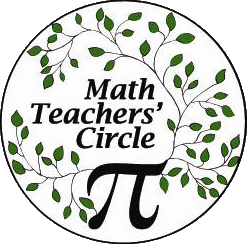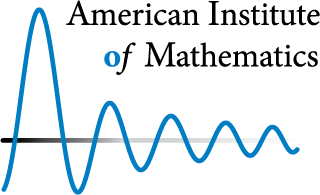
Spot It!
Spotting mathematical structure in a children’s game.
Tom Clark
Like the MTCircular? Subscribe to our free semi-annual magazine.
Mathematicians are fond of saying that mathematics can be found almost anywhere. Yet I was shocked to discover that a simple children’s game like Spot It! can lead to unsolved problems in mathematics. Deep mathematical structure lies just below the surface of the game.
Whenever I lead the Northwest Iowa Math Teachers’ Circle I want to use a problem that is easy to explain, unfolds in many directions, and encourages inquiry. Spot It! is the best session topic I have ever seen for this. All you have to do is play the game for a minute or two, and questions arise spontaneously.
The game is simple. Each player is dealt one card, and an extra card is dealt to the middle of the table. Each card contains eight symbols (in the junior version, each card contains six symbols). To win, a player must be the first to match a symbol on her card with a symbol on the middle card.
The first “aha” moment occurs when you realize that anyone can win—that is, there must be a match between any two cards. This prompts the question, “How does it work?” The symbols cannot be assigned randomly; there must be some deep structure built into the game. And where there is structure, there is mathematics.
Once the “aha” moment occurs, I ask, “What mathematical questions do you have?” I want the teachers to be curious, to make conjectures… and they do! Here is a list of questions that we came up with:
- Will every card really match with every other card?
- How many cards are in the deck? Could there be more cards? Fewer cards?
- Does each card have the same number of symbols?
- How many unique symbols are there? Does each symbol appear the same number of times?
- What is the relationship between the number of symbols per card, total number of symbols, and the total number of cards?
Now we get to spend the rest of the session trying to answer these questions. One approach is to lay out all the cards from the Spot It! Junior deck. There are 31 cards, each with six symbols. Careful counting reveals that there are 31 total symbols as well, and that each symbol appears exactly six times in the deck. Each card shares exactly one symbol with every other card. With some data on the table, I push for mathematical explanations of the patterns, while remaining flexible with directions of inquiry.
For example, participants might wonder how, with six symbols per card, we end up with a deck of 31 cards. Choose a Spot It! Junior card and set it to the side. It has six symbols on it, and every card in the deck matches one of those six. Let’s arrange the deck into six rows, based on the six symbols on our “key” card:

If all the cards in the first row have the green square symbol, then every card in that row contains a green square and five other symbols. If there are m cards in the row, then there are 6 + 5(m – 1) total unique symbols (6 for the key card, and 5 new ones for each other card in the row). Note that if m = 6, then this yields 31 symbols. But why should this be? Any card not in the “green square” list must share a match with every card in the green square row. But there are only six symbols on that card, so it can only match six cards in that row. The most possible cards the deck could hold is thus 31.
Now we can find a general formula connecting the number of cards, symbols per card, and symbols in the deck—assuming an optimal deck exists. How can we know if it does?
Enter projective geometry. The key insight here is that in geometry any two points determine a line. If you think of cards as “points,” and a set of cards that share a particular symbol as a “line,” then you’ve got a geometry. (If you have played the game of SET with your MTC, these two games together make a beautiful pairing—SET also defines a geometry, but it is a finite four-dimensional Euclidean geometry.) You can show very easily, both with the cards and also by reasoning, that Spot It! cards determine a non-Euclidean geometry, because there are no parallel lines. In fact, the key card idea shows this: any card defines six lines that all intersect at that card.

The image above depicts the geometry of a Spot It! deck with seven cards and three symbols per card. I recommend Deepu Sengupta’s “A Mathematical Analysis of Spot It!” for a deeper investigation of the geometry of the game. It is amazing, but it is also harder for the teachers to discover, so it will require some direction to investigate.
Another interesting direction is to consider how to build our own Spot It! deck. For example, maybe we can build a deck with two, three, four, or five symbols per card. Is there an algorithm to assign symbols? This process will help derive all the equations relating numbers of cards and symbols. I’ve written about this in more detail in my article, Analyzing Unique-Matching Games Using Elementary Mathematics. It is interesting how the construction breaks down in certain cases when a prime number condition is not satisfied, which also leads to the conclusion that this might not always be possible. This question of existence is in fact an open question in mathematics. A large supercomputer search showed that no Spot It! game exists with 11 symbols per card. The question is open for 13 symbols per card, outside the reach even of supercomputers.
In any MTC activity, I want teachers to practice making sense of problems, reasoning, constructing arguments, and looking for structure—the very things that their students should be doing, in line with the Common Core State Standards for Mathematical Practice. Spot It! provides so many opportunities to do so. Combinatorial arguments can show up as well as simple reasoning about patterns. It’s guaranteed to be a great session topic for any Circle.
This article originally appeared in the Winter/Spring 2017 MTCircular.
 |
Tom Clark is an assistant professor of mathematics at Dordt College, the leader of the Northwest Iowa MTC, and the Chair-Elect of the SIGMAA-MCST. |
MORE FROM THE
WINTER/SPRING 2017 MTCIRCULAR
![Crooked River MTC (Cleveland, OH) [1]](http://www.mathteacherscircle.org/wp-content/themes/mtc/assets/Crooked-River-MTC-Cleveland-OH-1-e1485499518808-150x150.jpg) |
A Teacher and a MathematicianMTCs have the potential to affect teachers’ beliefs about themselves and about mathematics
|
 |
A Circle in the DeltaA Math Teachers’ Circle extends a Math Science Partnership
|

|
Freeing the ClonesExploring paradox through mathematical games
|
 |
Taton Becomes Director of Mathematics for School District of PhiladelphiaJoshua Taton brings the MTC spirit to the School District of Philadelphia
|
 |
Bolognese, Davis, Phelps, Ray, Sudnick Win Ohio Teaching AwardsFive Ohio MTC members were recognized with awards from the Ohio Council of Teachers of Mathematics
|
 |
Capasso, Hill Win Presidential AwardsLiz Capasso (Fairfield County MTC) and Patty Hill (MTC Austin) win the nation’s highest recognition for math and science teachers
|

|
Danforth Presents at National ConferencesHeather Danforth (AIM MTC) presented on Math Teachers’ Circles at two conferences this fall
|
 |
A Note from AIM: Identities and ConnectionsAs the MTC Network grows larger, our understanding of how MTCs affects teachers deepens
|
 |
Dispatches from the CirclesLocal updates from across the country
|

|
OpportunitiesSpecial events, recognitions, careers
|

